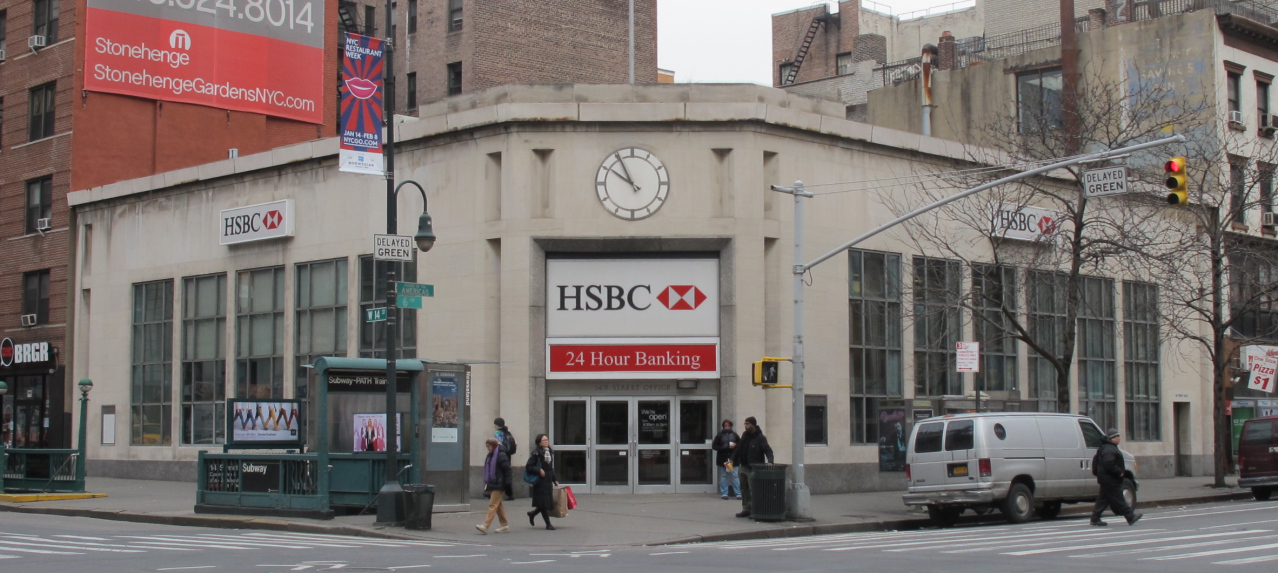Beyond the Village and Back: The Haier Building, 1352-1362 Broadway

In our series Beyond the Village and Back, we take a look at some great landmarks throughout New York City outside of Greenwich Village, the East Village, and NoHo, celebrate their special histories, and reveal their (sometimes hidden) connections to our neighborhoods.
Commanding the northern side of West 36th Street between Sixth Avenue and Broadway is what seems to be an imposing house of worship built by ancient Romans. Sitting within the frieze at top are bright gold letters that spell out “The Haier Building,” a paean to some corporate god of moderately priced appliances. On the lower floors is Gotham Hall, a 9,000-sq-ft event space worthy of Bacchus. When the Landmarks Preservation Commission designated the building at 1352-1362 Broadway in 1994, its report called it “a veritable temple to thrift” and “one of the finest examples of the academic classical architectural tradition in this country.” And that applies to not just landmarked exterior, but the extraordinary landmarked ground floor interior hall, which now serves as an event space for some of the most prestigious gatherings in New York City (and for Amazing Race fans, was thus far the only indoor finish line in the long-running show’s history).
Completed in 1924, the building was better known as the longtime home of the Greenwich Savings Bank, which was headquartered in this temple of finance until it was bought by another banking institution in 1981. Architects York & Sawyer designed the building as a symbol of the bank’s growth from its Greenwich Village origins in the early 19th century to a financial powerhouse centered in Midtown by the early 20th.

The architects crafted a building that combines the monumental classicism of McKim Mead & White, where Edward York and Philip Sawyer trained, with a more staid form of architecture that fits within the firm’s portfolio of bank buildings and academic institutions, including Downtown’s Federal Reserve Bank and the New-York Historical Society. Porticos featuring eight massive fluted Corinthian columns dominate both the main facade on Broadway and its narrower near-twin on Sixth Avenue. The building’s classically inspired arrangement — podium, major order, and attic — handily conceals the large elliptical banking room and six stories of offices behind an exterior of Indiana limestone and polished pink granite. “Philip Sawyer’s knowledge of ancient Roman prototypes,” the LPC noted in its designation report, “and his appreciation for the organization which characterizes eighteenth- and nineteenth-century French design and planning is demonstrated in the adaptation of the bank’s three facades to the irregular site.” In addition to being protected by local landmarks laws, the building was placed on the National Register of Historic Places in 2005.
While the bank gained a prominent home just north of Herald Square in the 1920s, its birth in Greenwich Village nearly 100 years prior is no less significant, tying into the expansion of the city of New York in the 1830s. In 1832, the population of Greenwich Village grew rapidly following a cholera epidemic that pushed many lower Manhattan residents out of “the city” and to the healthier environment available in the Village. To prepare the community for that growth, Don Alonzo Cushman — the namesake for elegant Cushman’s Row in Chelsea — and other local businessmen met at the Northern Dispensary on Waverly Place in 1833 to establish the Greenwich Savings Bank. It became the only savings institution in Greenwich Village, with its inaugural home on the first floor of a row house at 10 Carmine Street, just off Sixth Avenue. The bank expanded next door into 12 Carmine Street the following year, and in 1839 moved around the corner to a site on what was then 11 Sixth Avenue. (In 1922, buildings on Sixth were renumbered after the avenue was extended below Houston Street, so this address is not the same as the current 11 Sixth Avenue in Tribeca.)

As the institution grew, its central location slowly moved uptown along Sixth Avenue, somewhat mirroring Manhattan’s northerly expanding population. In 1846, the bank leased space on the northwest corner of Sixth Avenue and West 4th Street. Eight years later, its new building opened on Sixth Avenue and Waverly Place. The bank’s fifth home, opened in 1892, was on Sixth Avenue and West 16th Street, next to Saint Francis Xavier Roman Catholic Church. Long since demolished, the ornate structure was designed by architect Robert W. Gibson (best known for the Church Mission House on Park Avenue South, currently home to Fotografiska New York, and St. Michael’s Episcopal Church on the Upper West Side). When the Greenwich Savings Bank’s headquarters moved uptown 32 years later, the transfer of all its cash and securities — 26 trips “in armored cars and under the protection of machine guns” — was well covered by the New York Times.

After the headquarters moved, it took almost three decades for the bank to return to the area of its birth. In 1952, a branch was opened in a low, streamlined building on the corner of Sixth Avenue and 14th Street. The structure was torn down in 2019 to make way for a 13-story mixed-use residential building. That project also obliterated perhaps the last vestige of the 160-year-old financial institution: the painted Greenwich Savings Bank that had been painted on a building adjacent to the construction site.


Do you know what happened to the murals in the 14th St. building? Those of us who loved them hold out hope that they were saved.
I believe they were dismantled and stored with the hopes of finding a new home.